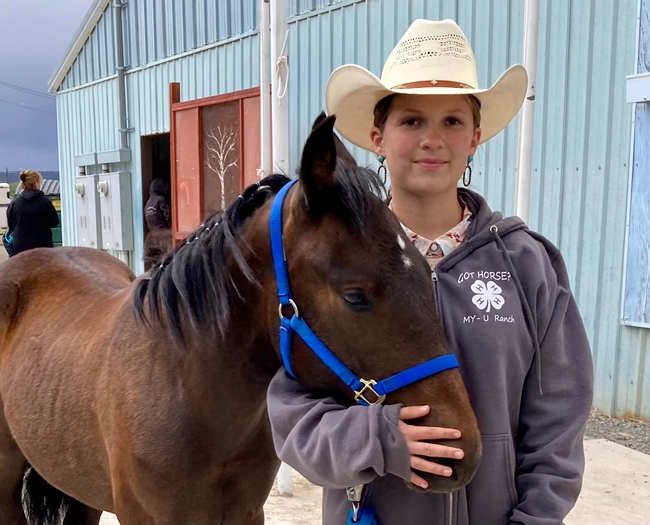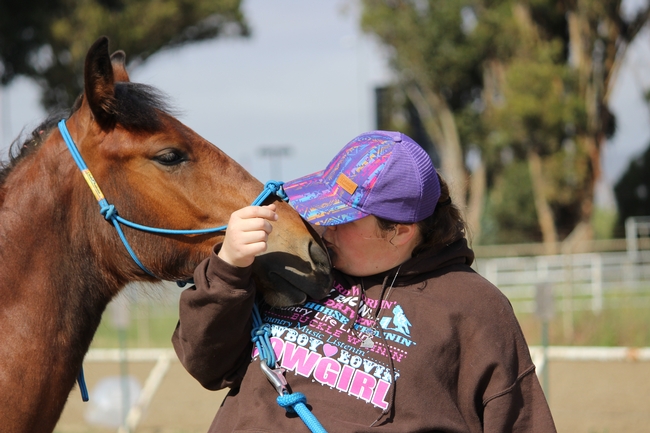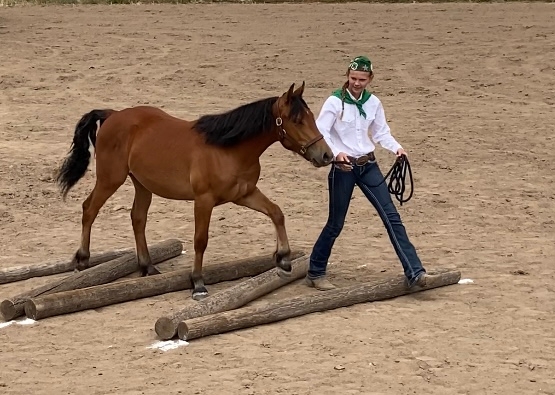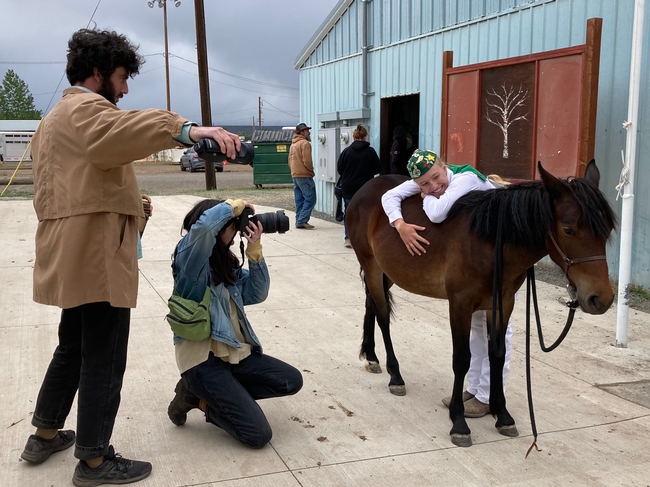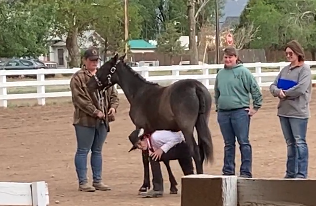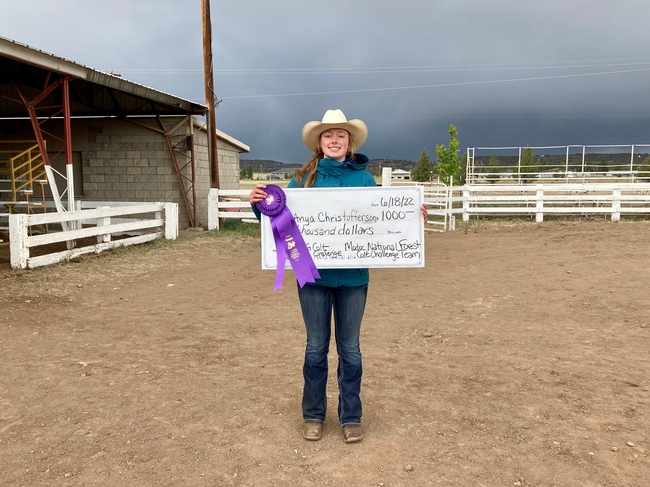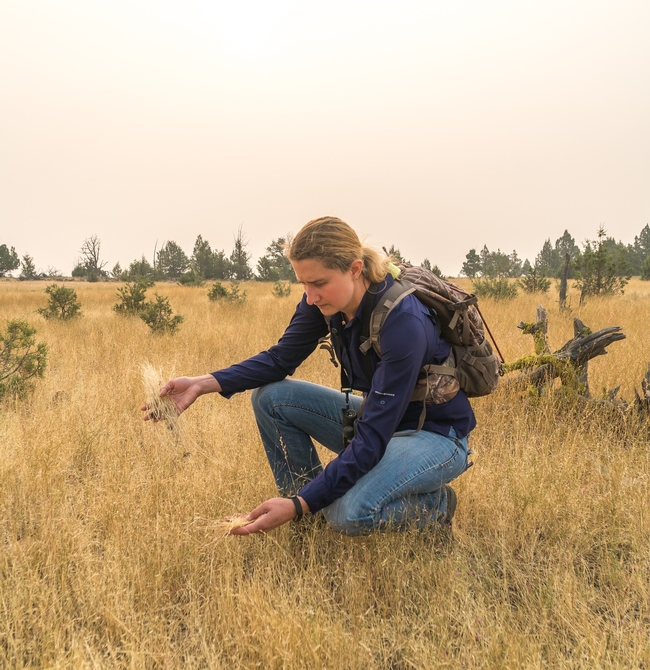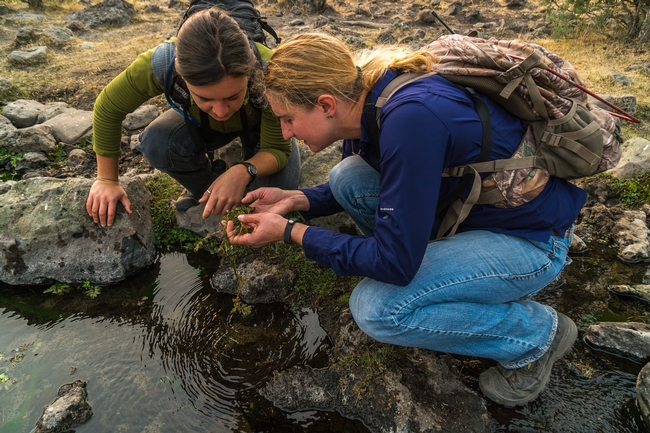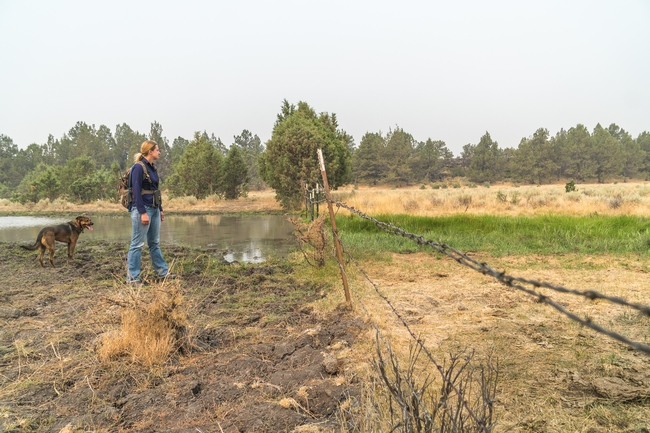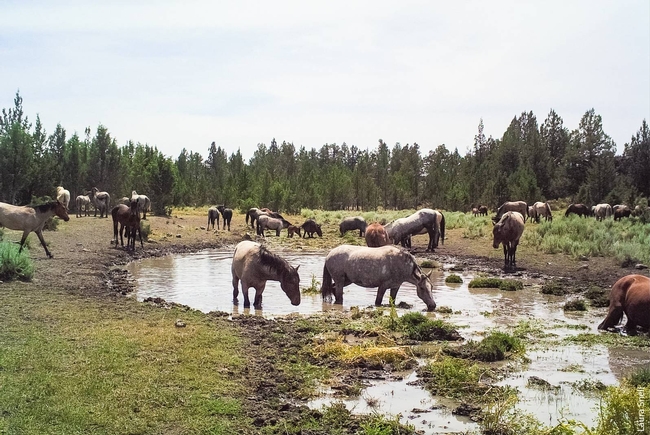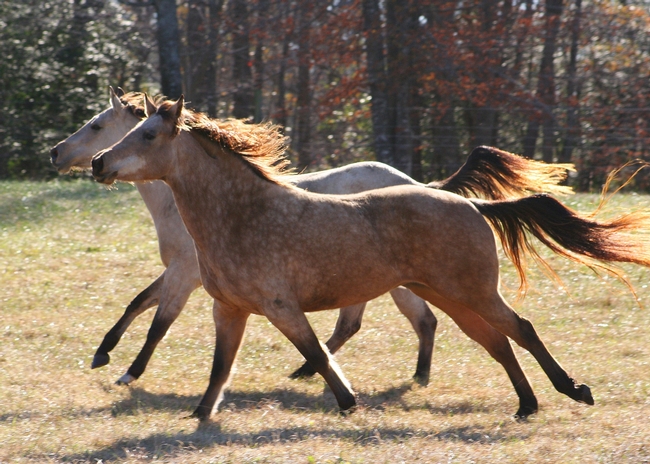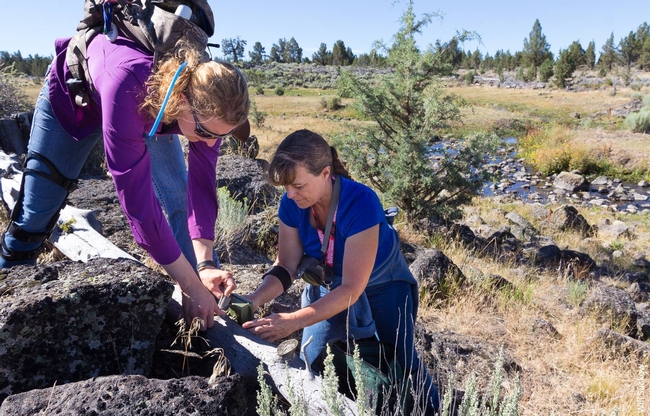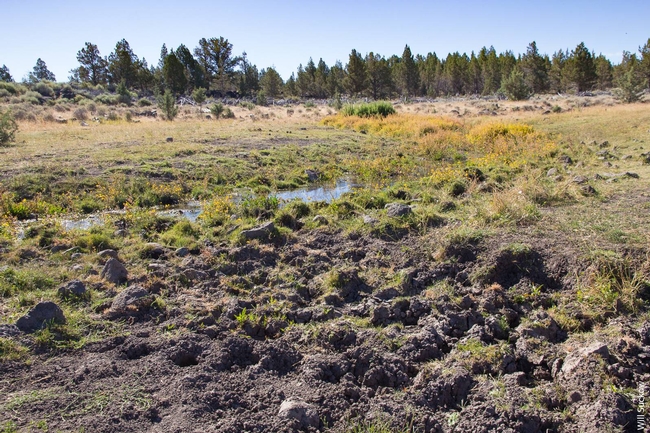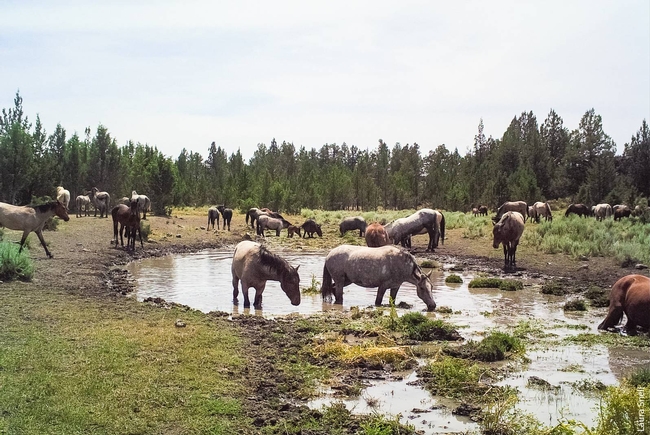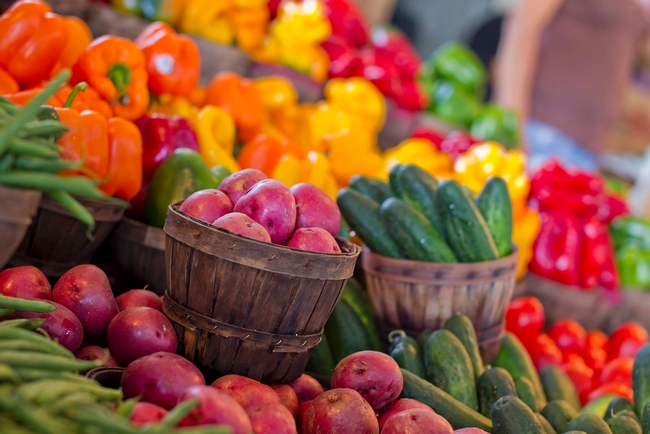Posts Tagged: horses
Wild horses and youth learn patience and trust from each other
“There is much we can learn from a friend who happens to be a horse.” — Aleksandra Layland
“Training mustangs is just so much fun,” said Aubrielle, as a chestnut-colored filly named Zuri nuzzled the 4-H member from Shasta County. Six months earlier, the young wild horse was wary of being touched. Now she was sporting accessories in her styled mane that matched the teenager's turquoise jewelry.
Over the past few years, UC Cooperative Extension in Modoc County has partnered with Modoc National Forest to provide public outreach and education to support the placement and care of wild horses from Devil's Garden at the northeastern corner of California. Adopting foals reduces overpopulation of wild horses, which can harm rangeland and the health of the mustangs themselves.
This year Laura Snell, UC Cooperative Extension livestock and natural resources advisor in Modoc County, assigned weanling wild horses to 40 youth between the ages of 9 and 19 from all over the state. The mustangs were 4 to 6 months old in January when they were picked up in Alturas and taken home by California 4-H and FFA members, who feed and care for them.
“The moment when I got to touch him for the first time is probably one of the biggest parts of training as well as my progress with him,” said Morgan of Monterey County, who spent hours in the stall with Bowie trying to gain his trust.
“It was really amazing to me that I was able to touch him on day 5,” she said. “In the videos I watched leading up to getting him, most of the time it took one week to three weeks for the people in the videos to touch their wild mustangs. At that moment is when you really start to make that bond with a wild mustang.”
“The moment when I got to remove his tag was a huge part as well because at that moment you know that the mustang trusts you enough that he is letting you get that close to remove the tag,” Morgan said.
The young trainers teach the horses to wear a halter, to load and unload from a horse trailer and to navigate through obstacles. Some participants also work on tricks such as laying their horse down, walking the horse backward and walking under the horse. In June, the participants gathered in Alturas to show their progress.
“It provides them an opportunity to seek out adult mentors who are horse trainers, learn responsibility, and learn a variety of things about caring for a wild horse and learning more about themselves in the process,” said Snell.
“We find that the youth do very well with wild horses. It's really a two-way street, with the horses learning just as much as the youth are in the six months they are in training,” she added.
Sisters Kailey and Maddi in San Benito County both adopted weanling horses. Removing the tag after about three weeks was a turning point for Maddi and her horse Fiona.
“The significance of getting the tag off was we hadn't been able to get near her at all,” said Maddi. “She had some aggression toward people out of fear. So getting past that, getting to the point where she trusted me and I could get that halter on her and get close enough to get that tag off was just a huge achievement. After that, once she trusted me, she started doing really, really well and flying through her training.”
Because wildfires are part of life in California, she taught Fiona to step over flames so she won't be afraid if they need to evacuate, Maddi told KSBW reporter Brisa Colon.
“It has been amazing to be able to share this experience with another very close family,” said Aubrielle's mother Ashley Phipps. “Our daughters have gone through the entire journey together starting with visiting the corrals to pick horses together, all the way through the training process. My daughter is older than Brooklin and has been a great mentor to her, teaching Brooklin and her horse along the way. It has been such a confidence builder for my daughter! Our girls will never forget this experience!!! And I loved every moment of watching them grow through the ups and downs. This program is such a blessing.”
To qualify for the program, applicants must fill out an application which includes being enrolled in a horse program such as the 4-H Equine Project, show they have facilities and feed for the animals, designate a mentor and have their parents' approval.
The trainers and their horses competed in the Devil's Garden Colt Challenge on June 18 in Alturas, vying for awards in halter, showmanship and obstacle course with youth from 13 counties participating. Prizes totaled over $3,000.
UCCE director finds place among women leaders of Modoc County
When Laura Snell first came to the far northeastern corner of California, she was amazed to find that the Board of Supervisors in Modoc County – where cows outnumber people by a ratio of 13 to 1 – was composed almost entirely of women.
Snell, who arrived in the high desert town of Alturas in 2015 as the University of California Cooperative Extension livestock and natural resources advisor, said she now has a theory as to why.
“It's a great example of the rural and agricultural lifestyle we have here where women get involved in everything from civic organizations to local government,” she said. “In a lot of ways, there isn't a glass ceiling in an area where everyone is needed and most people are wearing multiple hats to keep the community going.”
Snell has worn the “county director” hat for UCCE in Modoc County since 2017, bringing a range of UC Agriculture and Natural Resources programs to local communities. In the subsequent years, she has established herself as one of the region's most prominent and respected voices.
“Laura is a strong leader, an excellent communicator, and extremely knowledgeable in the fields of wild horses, groundwater, livestock and grazing – among many other topics,” said Geri Byrne, vice chair of Modoc County's Board of Supervisors (which is presently 75% female).
Snell's broad base of knowledge – as well as her bachelor's in water science and master's in agronomy, both from the University of Nebraska – have served her well in her dream job in a “one-advisor” county.
“This is what I always wanted to do – know a little bit about a lot of things and be the person who connected people with what they needed, connecting them with information, connecting them with different experts,” Snell explained.
One of her most recent accomplishments is launching UC Master Food Preserver classes in Modoc County this year. About 130 people – in a county of 9,000 – have been served by this UC ANR program, and four are on the cusp of graduating as Modoc's inaugural class of certified Master Food Preservers. The vast majority of program participants, Snell notes, have been women.
“They're not only preserving for their own families; they're also using these tools and harvesting things from their gardens and then having a value-added product to sell at the farmers market and our local food hub,” said Snell, citing one participant who learned how to make and sell celery salt.
The contributions of women to the local economy, county leadership and organizations such as the Modoc County Cattlewomen's group continue to inspire Snell in her work – and in nurturing the next generation of leaders.
An avid participant in 4-H growing up in Story County, Iowa, Snell said one of the most fulfilling aspects of her job is mentoring the interns who come through her office, and presenting them with opportunities to learn and grow in their careers.
It was a personal connection that brought Snell to Modoc. A former Bureau of Land Management director in the county, who happened to be the father of her college friend, encouraged Snell to apply for the advisor position. So she flew from Nebraska to Reno and then made the three-hour drive north for the interview.
“I loved it; I immediately loved it,” Snell recalled. “I called my parents that night and said, ‘If they offer me this job, I'm staying.' This is it – this is what I've always really wanted to do, but not only that: this is the kind of community I've always wanted to live in.”
Snell – along with her canine companion, an Airedale-German Shepherd-Rottweiler mix named Zuri – have become an essential part of the fabric of Modoc County. She has provided guidance on everything from managing wild horses on the Devil's Garden Plateau to optimizing agritourism operations for greater profitability to improving the livelihoods of farmers and ranchers by alleviating regulatory burdens.
“Working in this county and for this county, for the people here, that's what fills my cup,” she said. “That's what is most satisfying about this work.”
And the county, in turn, has been appreciative of Snell's wide-ranging expertise and unflappable demeanor. According to Supervisor Byrne, Snell has been instrumental in taking on complex issues such as wild horses and the Big Valley Groundwater Sustainability Plan – four years in the making and greatly enhanced by Snell's background in water and her passion for bringing science to the people.
“Laura has a ready smile and manages to stay calm in the face of adversity,” Byrne said. “Modoc is very blessed to have such an articulate, knowledgeable, hard-working and personable director.”
Federal officials are reducing the wild horse herd in Modoc County
Officials with the Modoc National Forest are rounding up 1,000 wild horses on federal lands and putting them up for sale and adoption, reported Christina Maxouris and Brandon Griggs on CNN.com
About 4,000 wild horses live on Devil's Garden Plateau, a protected territory inside Modoc National Forest near the Oregon border. It's home to the largest herd of wild horses in the country managed by the U.S. Forest Service.
"With a population growth rate of 20-25 percent, 800-1,000 wild horses will be born on the Devil's Garden this year, making these small removals negligible," said Laura Snell, UC Cooperative Extension advisor in Modoc County.
Snell's research on wild horses at Devil's Garden was chronicled in California Agriculture journal by executive editor Jim Downing. The federal government has determined the ideal horse population on the 230,000 acres of wild horse territory is no more than 402, however, more than 4,000 wild horses are running on the land.
The current federal horse gathering was prescribed by the 2013 Devil's Garden Plateau Wild Horse Territory Management Plan to help address impacts on aquatic resources, wildlife, grazing and traditional cultural practices. Reducing the population will allow range and riparian ecological conditions to recover, while also supporting wild horse herd health by reducing competition for limited food, water and habitat, according to a Modoc National Forest press release.
Most gathered horses are expected to be under 10 years old and will be available for adoption at the BLM Litchfield Corrals. Gathered horses 10 and older will be cared for at the new Double Devil Wild Horse Corrals on the Modoc National Forest and offered for adoption and sale. To adopt a young horse, see https://www.blm.gov/adoptahorse/ or wildhorse@blm.gov. To adopt or purchase an older horse go to https://go.usa.gov/xQ3r3.
Wild horse over-population is causing environmental damage
Most Americans envision healthy mustangs galloping free on the range when they think about the country's wild horse population. But UC Cooperative Extension rangeland advisor Laura Snell sees another image.
In conducting research on the over-populated wild horse territory at Devil's Garden Plateau in Modoc County, she witnesses a group of horses visiting a dwindling and damaged pond.
“Maybe there is enough for the lead stallion and the lead mare to drink. The rest stand there and look longingly at the diminished water source,” Snell said. “They do not seem content.”
The research Snell has underway at Devil's Garden was chronicled in the current issue of California Agriculture journal by executive editor Jim Downing. The federal government has determined the ideal horse population on the 230,000 acres of wild horse territory is no more than 402, however, more than 2,000 wild horses are running on the land.
Snell began working in the remote northeast corner of California in 2015.
“I had Modoc County ranchers coming up to me on my second day of work asking me how to solve the wild horse issue,” she said.
She realized that agencies and authorities responsible for policies that determine the horses' fate, and advocates who lobby strongly that the horses should be cared for humanely, don't see the poor conditions suffered by the horses and the environmental degradation of the land.
“The area is a quarter million acres in size. There are no main roads, so you have to take ATVs to see the horses,” Snell said. “We realized we needed to provide visuals to show people the horses and what the landscape looks like due to unmanaged grazing by the wild horses.”
Snell places wildlife cameras for two-week periods near 24 remote water sources in wild horse territory in Modoc and Lassen counties. At each site, the camera takes a burst of three pictures automatically every 15 minutes; motion detectors on the cameras also trigger a shot whenever an animal enters the field of view.
Preliminary data from 2015 show some striking findings. At one spring site, for instance, more than 71 percent of all animals detected over the sampling period were horses. Cattle accounted for 19 percent and the rest were pronghorn antelope, deer and hawks. The study will continue through 2017.
Wild horses are running in the Devil's Garden territory, and outside the territory, on private and tribal land. Fences don't hold the horses in, Snell said. Federal wild horse management areas are intended for multiple uses, including livestock grazing, hunting, and wildlife habitat. But in Devil's Garden, livestock have been excluded because of the environmental degradation.
“It was never intended to be single use area,” Snell said. “The horses are gorgeous animals, but I also like to see pronghorn, elk and mule deer. Some groups of wild horses are getting large and studs are getting aggressive. I know people who no longer ride their personal horses because it's not really safe with the territorial nature of the stallions.”
The images and data from Snell's research are designed to inform management and policy decisions in hopes of easing the expensive and environmentally harmful wild horse over-population. Already U.S. Representative Doug LaMalfa (R-Oroville) has brought the study to the House Committee on Natural Resources and preliminary results have been shared with Bureau of Land Management's Wild Horse and Burro Advisory Board.
What's in your compost?
For home gardeners, spring is a busy time of year and there’s never a tomato with more flavor than one grown to full ripeness on the vine. But there are also many safety precautions to follow to prevent contamination of fruits and vegetables with pathogens that cause serious food-borne illnesses.
Michele Jay-Russell, a veterinarian and research microbiologist at the Western Institute for Food Safety and Security (WIFSS) and program manager of the Western Center for Food Safety (WCFS), recently co-authored a study that highlights the need to be aware of the hazards associated with using raw animal manure to fertilize home gardens. (Read full article here.)
The basis for the study began in July of 2010 when a shire mare from a rural Northern California farm was brought to the William R. Pritchard Veterinary Medical Teaching Hospital for treatment of colic. Following protocol, the veterinarians on call screened the horse for Salmonella to avoid infecting other horses during hospitalization. She tested positive and after successful treatment for colic, went home. Her owners then notified the veterinarians that some of their other draft horses were sick as well — all 8 were tested and 6 came back positive for the same Salmonella Oranienburg strain, including the mare that still had the infection.
Jay-Russell heard about the case from her colleague John Madigan, professor of medicine and epidemiology at the school. The farm’s owners invited Jay-Russell and Madigan to the farm to see if they could uncover the source of the Salmonella infection. They sampled water from horse troughs, manure storage piles, wild turkey feces and soil from the family’s edible home garden where raw horse manure had been used as fertilizer. Each of those locations had a percentage of positive samples over the sampling period from August 2010 to March 2011.
“We showed the owners how to continue collecting samples and provided them with a FedEx number to ship them to UC Davis,” Jay-Russell said. “During that whole time, the garden soil kept coming back positive, which showed that this strain of Salmonella could persist for months.”
While the researchers couldn’t be completely certain about the original source of Salmonella on the farm, they suspect that a recent surge in the wild turkey population on the property introduced the bacteria to the horses by pooping in the horse corrals and in the water troughs. They speculated that the wild turkeys brought the Salmonella onto the property, although they couldn’t rule out the possibility that the birds were exposed on the farm or to other potential sources of Salmonella.
“What is clearer is that the raw horse manure applied as fertilizer was the most likely source of garden soil contamination,” Jay-Russell explained. “We suspect that the damp climate in Mendocino County may have contributed to the longevity of this bacterium in the soil long after the owners stopped applying the horse manure to the garden. Fortunately, the owners didn’t get sick, but our investigation showed the potential for widespread dissemination of Salmonella in a farm environment following equine infection.”
To promote safe gardening practices, Jay-Russell has teamed with Trevor Suslow, a Cooperative Extension food safety specialist in the Department of Plant Sciences, to speak to groups of small farmers around the state about best practices. They also use a brochure in English and Spanish, “Food Safety Tips for Your Edible Home Garden,” that includes information about safe uses of animal manure and ways to minimize animal fecal contamination.
“It’s good to let people know about the risks and to correct misinformation about ways to treat the compost pile before using it in the garden,” Jay-Russell said. “The biggest take home message from this experience is to be very careful about using manure from sick horses — and to be cautious about offers of free manure — you don’t know what’s in there. Commercial compost should be bought from a reputable source.”
She urges gardeners to take a class and learn how to compost correctly and safely. Each county in California has UC Cooperative Extension advisors and many have Master Gardener programs offering information on food safety.
Additional resources:

